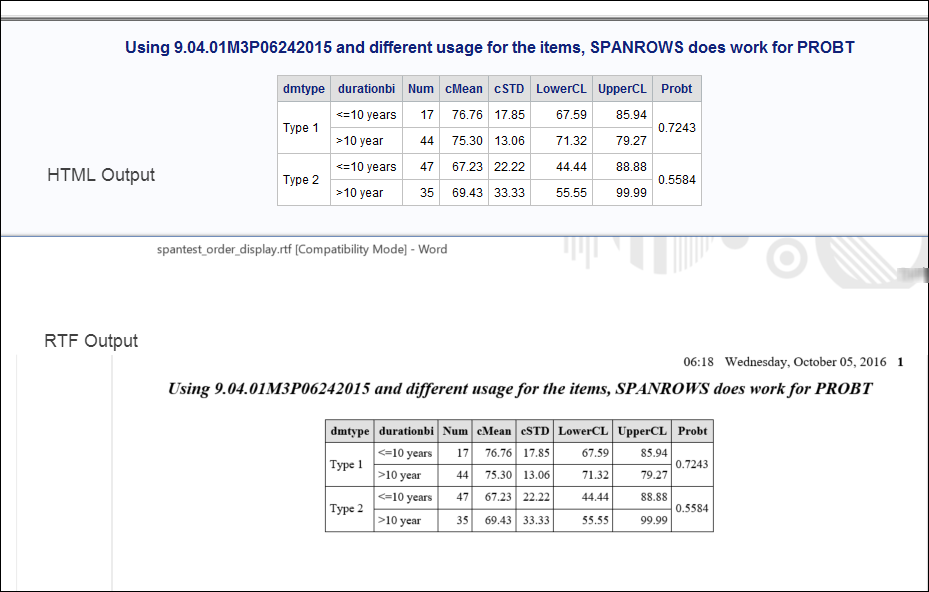- Home
- /
- Programming
- /
- ODS Reports
- /
- Proc Report, Merging cells when grouped and vertical center
- RSS Feed
- Mark Topic as New
- Mark Topic as Read
- Float this Topic for Current User
- Bookmark
- Subscribe
- Mute
- Printer Friendly Page
- Mark as New
- Bookmark
- Subscribe
- Mute
- RSS Feed
- Permalink
- Report Inappropriate Content
So this is my dataset from using the ODS output with proc ttest:
This is my code so far for proc report
options orientation=portrait;
ods rtf file="H:\temp.rtf" startpage=no nokeepn style=&mvSTYLE %wordstyle ;
proc report data=table3way headskip nowindows split='~'
style(report)={font_size=9pt just=left cellpadding=2pt}
style(header)={just=center font_weight=bold font_size=9pt background=CXE0E0E0}
style(column)={cellheight=13pt font_size=9pt asis=on protectspecialchars=on}
style(lines)={font_size=8pt asis=on};
column dmtype Durationbi Num cMean cSTD LowerCL UpperCL Probt;
define dmtype/group style(column)=[vjust=middle just=left];
define Durationbi /display;
define num/display;
define cMean/display format=9.2;
define cSTD/display format=9.2;
define LowerCL/display format=9.2;
define UpperCL/display format=9.2;
define Probt/group style(column)=[vjust=middle just=left];
run;
footnote;title2;
ods rtf close;
And this is the RTF table I have based on the proc report above
So I want the Type of Diabetes cell and p-value cell merged and vertically centered, so there is no blank cell under it, basically to look like this:
How do I do this? I did add the Vjust=middle option for the two variables... But I guess I have to add in another line of code somewhere to merge the cells? Can someone please help me?
I did try looking at the solution outlined here, but I don't have missing data (Someone suggested doing "If not missing(pvalue) then _pvalue=pvalue; else pvalue=_pvalue; " I did try it with the retain function, but it didn't do anything since I didn't have missing data., so it pretty much copying the variable
Thanks!!
Edit: I also tried adding the SPANROW option on the Proc report statment and order=data option on the define statement as outlined here. And it didn't work either. I am on SAS 9.4 and the option wasn't blue so unsure if it was removed between 9.2 to 9.4.
Accepted Solutions
- Mark as New
- Bookmark
- Subscribe
- Mute
- RSS Feed
- Permalink
- Report Inappropriate Content
Hi:
When I run a slightly modified version of your code in SAS 9.4 M3, I do see the results you want with SPANROWS. Since you really are not grouping, I changed the usages to ORDER and DISPLAY.
Here's the output:
And the code that produced the output (with a DATA step to make some fake data) is below.
cynthia
Here's the code:
data table3way;
length dmtype durationbi $15;
infile datalines dlm=',' dsd;
input dmtype $ ordvar Durationbi $ Num cMean cSTD LowerCL UpperCL Probt;
return;
datalines;
"Type 1",1,"<=10 years",17,76.76,17.85,67.59,85.94,0.7243
"Type 1",2,">10 year",44,75.30,13.06,71.32,79.27,0.7243
"Type 2",1,"<=10 years",47,67.23,22.22,44.44,88.88,0.5584
"Type 2",2,">10 year",35,69.43,33.33,55.55,99.99,0.5584
;
run;
proc sort data=table3way;
by dmtype ordvar durationbi;
run;
options orientation=portrait;
ods html(id=ht) file="c:\temp\spantest_order_display.html";
ods rtf file="c:\temp\spantest_order_display.rtf" ;
title "Using &sysvlong4 and different usage for the items, SPANROWS does work for PROBT";
proc report data=table3way nowindows split='~' spanrows
style(report)={font_size=9pt }
style(header)={just=center font_weight=bold font_size=9pt background=CXE0E0E0}
style(column)={font_size=9pt protectspecialchars=on};
column dmtype Durationbi Num cMean cSTD LowerCL UpperCL probt;
define dmtype/order style(column)=[vjust=m just=l];
define Durationbi /display;
define num/display;
define cMean/display format=9.2;
define cSTD/display format=9.2;
define LowerCL/display format=9.2;
define UpperCL/display format=9.2;
define probt / order style(column)={vjust=m just=l};
run;
footnote;title;
ods rtf close;
ods html(id=ht) close;- Mark as New
- Bookmark
- Subscribe
- Mute
- RSS Feed
- Permalink
- Report Inappropriate Content
Hi:
When I run a slightly modified version of your code in SAS 9.4 M3, I do see the results you want with SPANROWS. Since you really are not grouping, I changed the usages to ORDER and DISPLAY.
Here's the output:
And the code that produced the output (with a DATA step to make some fake data) is below.
cynthia
Here's the code:
data table3way;
length dmtype durationbi $15;
infile datalines dlm=',' dsd;
input dmtype $ ordvar Durationbi $ Num cMean cSTD LowerCL UpperCL Probt;
return;
datalines;
"Type 1",1,"<=10 years",17,76.76,17.85,67.59,85.94,0.7243
"Type 1",2,">10 year",44,75.30,13.06,71.32,79.27,0.7243
"Type 2",1,"<=10 years",47,67.23,22.22,44.44,88.88,0.5584
"Type 2",2,">10 year",35,69.43,33.33,55.55,99.99,0.5584
;
run;
proc sort data=table3way;
by dmtype ordvar durationbi;
run;
options orientation=portrait;
ods html(id=ht) file="c:\temp\spantest_order_display.html";
ods rtf file="c:\temp\spantest_order_display.rtf" ;
title "Using &sysvlong4 and different usage for the items, SPANROWS does work for PROBT";
proc report data=table3way nowindows split='~' spanrows
style(report)={font_size=9pt }
style(header)={just=center font_weight=bold font_size=9pt background=CXE0E0E0}
style(column)={font_size=9pt protectspecialchars=on};
column dmtype Durationbi Num cMean cSTD LowerCL UpperCL probt;
define dmtype/order style(column)=[vjust=m just=l];
define Durationbi /display;
define num/display;
define cMean/display format=9.2;
define cSTD/display format=9.2;
define LowerCL/display format=9.2;
define UpperCL/display format=9.2;
define probt / order style(column)={vjust=m just=l};
run;
footnote;title;
ods rtf close;
ods html(id=ht) close;
April 27 – 30 | Gaylord Texan | Grapevine, Texas
Registration is open
Walk in ready to learn. Walk out ready to deliver. This is the data and AI conference you can't afford to miss.
Register now and lock in 2025 pricing—just $495!
Learn how use the CAT functions in SAS to join values from multiple variables into a single value.
Find more tutorials on the SAS Users YouTube channel.
SAS Training: Just a Click Away
Ready to level-up your skills? Choose your own adventure.







